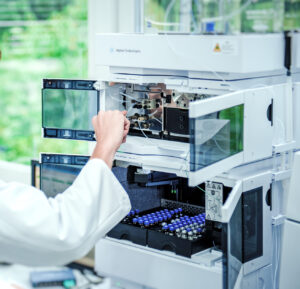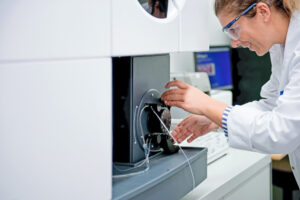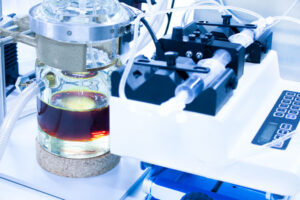Gas chromatography coupled with mass spectrometry
GC-MS, a key technology in chemical analysis. It identifies and quantifies organic compounds.
We separate complex organic mixtures using our modern gas chromatograph (GC) coupled with a mass spectrometer (MS) in our accredited laboratories. This results in reliable qualitative and quantitative results that we also know how to interpret.
Our focus
analysis of volatile molecules
Our specialized knowledge in the analysis of small and volatile organic molecules using GC-MS is of great value in areas such as environmental testing and food safety We are able to precisely analyze volatile organic compounds, which are present at low concentrations and are often difficult to detect, in the liquid phase (direct injection, AOC-20i) or in the gas phase (headspace, HS-20Trap). This capability is crucial for monitoring environmental contaminants, ensuring food safety and complying with legal limits.
Identifying unknown compounds
Our GC-MS technology enables us to accurately identify unknown chemical compounds in a variety of samples. This capability is particularly valuable in industries where knowing the exact chemical composition is critical, such as in the pharmaceutical and food and beverage industries. Our expertise allows us to break down complex compounds and precisely determine individual elements, which is essential for product development, quality assurance and safety assessments.
quantitative analysis
Our GC-MS services provide the ability to accurately quantify the concentrations of compounds in samples. This capability is particularly important for quality assurance and regulatory compliance. We help companies ensure that their products meet the required standards, whether it is monitoring the levels of active ingredients in pharmaceutical products or verifying the composition of food.
Unsure whether GC-MS is the right method?
Key data of our GC-MS
| investigation method | gas chromatography-mass spectrometry (GC) |
| abbreviation | GC-MS, GC FID, GC HS |
| Device type and equipment | GCMS-SQ2020 (Shimadzu) with HS-20Trap, AOC20i (autoinjector) and SPL/FID analysis line, GC 6890 (Agilent) withHeadspace oder Direktinjektion |
| functional principle | Separation of individual compounds in a gas chromatograph (if necessary, detection by means of FID). Subsequently, the components of these compounds are analyzed in the mass spectrometer to obtain data on their chemical composition. |
| Typical applications | Pharmaceuticals (e.g. purity, contaminants, residual solvents), food (e.g. pesticides) and plastics (e.g. emission analysis) |
| detection limit | depending on the analyte and method. The detection limit of tetrahydrocannabinol, for example, is 0.1 ng/mL |
| Requirements for sample | dependent on the analyte and method |
Methods that might also interest you
An overview of further methods from various fields of chemical analysis:




